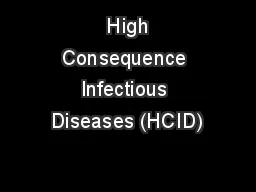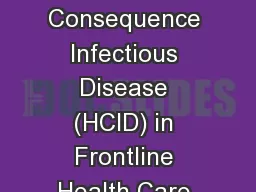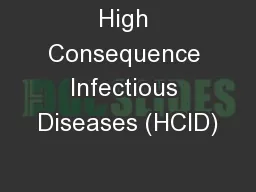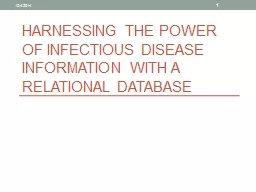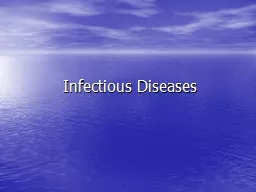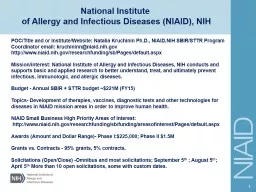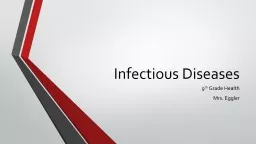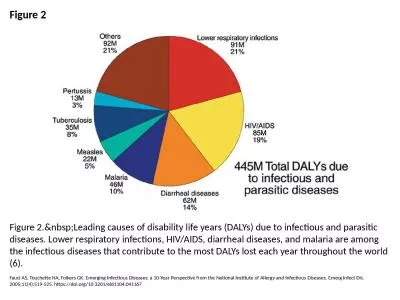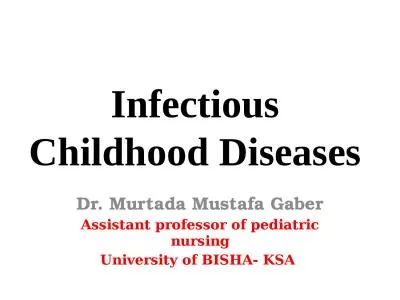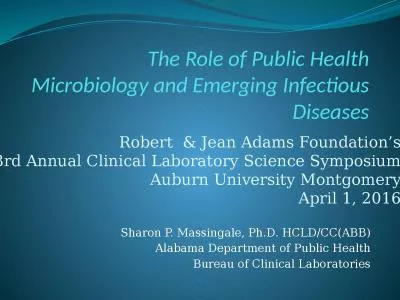PPT-High Consequence Infectious Diseases (HCID)
Author : marina-yarberry | Published Date : 2020-04-04
Disease Specifics High Consequence Infectious Diseases Middle East Respiratory Syndrome MERS Ebola Virus Disease EVD Marburg hemorrhagic fever Marburg HF Lassa
Presentation Embed Code
Download Presentation
Download Presentation The PPT/PDF document " High Consequence Infectious Diseases (H..." is the property of its rightful owner. Permission is granted to download and print the materials on this website for personal, non-commercial use only, and to display it on your personal computer provided you do not modify the materials and that you retain all copyright notices contained in the materials. By downloading content from our website, you accept the terms of this agreement.
High Consequence Infectious Diseases (HCID): Transcript
Disease Specifics High Consequence Infectious Diseases Middle East Respiratory Syndrome MERS Ebola Virus Disease EVD Marburg hemorrhagic fever Marburg HF Lassa Fever CrimeanCongo Hemorrhagic Fever CCHF . What is an Infectious Disease?. Any disease that is caused by an agent that has invaded the body.. These are caused by:. Person to person contact. Food and water. Animals. Something in the environment. Key Question. Primary Consequence. Primary Consequence. Primary Consequence. Primary Consequence. Primary Consequence. Secondary Consequence. Secondary Consequence. Tertiary Consequence. Tertiary Consequence. Cause and Consequence. - Change is driven by multiple causes, and results in multiple consequences- complex web of interrelated short-term and long-term causes and consequences. - Causes that lead to an event vary in their influence, with some being more SIGNIFICANT than others. www.health.state.mn.us/divs/idepc/dtopics/hcid/index.html. HCID Background. We live in a world where people travel the globe and pathogens evolve. These forces make health care facilities throughout the state vulnerable to risks posed by High Consequence Infectious Diseases (HCID) infections, such as Ebola Virus Disease (EVD), Middle East Respiratory Syndrome, and others that are easily transmissible, highly fatal, and not preventable through routine vaccines. Delayed detection and isolation of HCIDs may result in spread to others in health care facilities and the community. . Disease Specifics. High Consequence Infectious Diseases (HCID). Middle East Respiratory Syndrome (MERS). Ebola Virus Disease (EVD). Marburg hemorrhagic fever (Marburg HF). Lassa Fever . Crimean-Congo Hemorrhagic Fever (CCHF) . Kurt Buchanan, CFM. Economist. Mapping, Modeling, and Consequences Center. US Army Corps of Engineers. Huntington, WV. Overview. Corps Dam Safety Program overview . Consequence Estimation Using HEC-FIA (Flood Impact Analysis). database. 10/4/2014. 1. Presenter Disclosures. I . developed. “IDdx: Infectious Disease Queries” which is currently a free download from . Apple Store. (. iPhone. or . iPad. ) and . Google Play. Infection: Results when a pathogen invades and begins growing within the host. Disease: Results only if and when normal tissue function is impaired. The body has defense mechanisms to prevent infection (i.e. burns, skin lesions). POC/Title and or Institute/Website. : Natalia Kruchinin . Ph.D., . NIAID,NIH SBIR/STTR . Program . Coordinator email: . kruchininn@niaid.nih.gov. http. ://. www.niaid.nih.gov/researchfunding/sb/Pages/default.aspx. DOREEN SITALI. SCHOOL OF PUBLIC HEALTH. DEPT. OF HEALTH PROMOTION AND EDUCATION. Introduction. . Global eradication of smallpox in 1977 and discovery of antibiotics led to optimism and complacency that infectious diseases as public health problems could be eradicated or eliminated. Grade Health. Mrs. . . Eggler. Infectious Diseases. A.K.A., Communicable Diseases. Infectious Diseases . caused by organisms that are so small you need a microscope to see them.. Microorganisms. are the organisms that are so small you need a microscope to see them.. Fauci AS, Touchette NA, Folkers GK. Emerging Infectious Diseases: a 10-Year Perspective from the National Institute of Allergy and Infectious Diseases. Emerg Infect Dis. 2005;11(4):519-525. https://doi.org/10.3201/eid1104.041167. Dr. Murtada . Mustafa Gaber. Assistant professor of pediatric . nursing. University of BISHA- KSA. . Learning objectives . By the end of this lecture the student should be able to. :. Define infectious childhood disease.. Sharon P. Massingale, Ph.D. HCLD/CC(ABB). Alabama Department of Public Health. Bureau of Clinical Laboratories. Robert & Jean Adams. . Foundation’s. 3rd . Annual Clinical Laboratory Science .
Download Document
Here is the link to download the presentation.
" High Consequence Infectious Diseases (HCID)"The content belongs to its owner. You may download and print it for personal use, without modification, and keep all copyright notices. By downloading, you agree to these terms.
Related Documents

